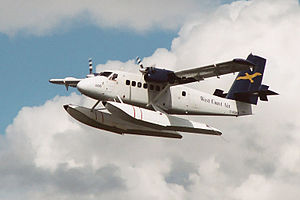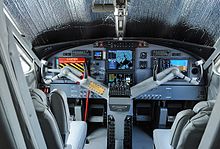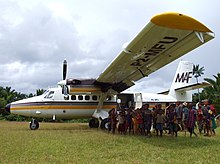de Havilland Canada DHC-6
| de Havilland Canada DHC-6 Twin Otter | |
|---|---|
 Seaplane DHC-6 "Twin Otter" |
|
| Type: | Turboprop - commuter aircraft |
| Design country: | |
| Manufacturer: | |
| First flight: |
May 20, 1965 |
| Production time: |
|
| Number of pieces: |
981 (January 26, 2020) |
The DHC-6 Twin Otter is a 19-passenger STOL aircraft originally manufactured by de Havilland Canada and later by Bombardier . After a twenty-year break in production, the modernized version DHC-6-400 is offered today by the Canadian manufacturer Viking Air , which acquired the manufacturing rights from Bombardier Aerospace in February 2006 .
The turboprop machine is designed as a shoulder- wing aircraft and has a fixed landing gear or float . The controllable pitch propellers allow the use of reverse thrust . The aircraft is optimized for very short runways and only requires a runway length of 366 m. It does not have a pressurized cabin .
history
The DHC-6 had its maiden flight on May 20, 1965. Production ended for the time being in 1988, by then 844 machines had been built. Of these, 575 flew in 2007.
In 2006 Viking Air acquired the production rights from Bombardier Aerospace , and in December 2007 production began again. The first flight of the version called DHC-6-400 took place on October 1, 2008 in Victoria , Canada . The first flight of the first series aircraft with the aircraft registration C-FMJO took place on February 16, 2010. After the official approval, the first three machines were delivered to the Swiss Zimex Aviation on January 17, 2011 , to Air Seychelles on January 26, 2011 and on January 6 , 2011 . Delivered to Trans Maldivian Airways in May 2011 .
137 DHC-6-400 had been built by the end of January 2020.
Versions
In addition to the standard version with wheels, there are versions of the Twin Otter with floats or runners. For tourist purposes, e.g. B. Sightseeing flights , there is a "Vistaliner" version with larger windows.
- DHC-6 series 100
- Basic version with two 432 kW Pratt & Whitney Canada PT6A -20 turboprop engines. 115 pieces built.
- DHC-6 series 200
- Improved version. Also built 115 pieces.
- DHC-6 series 300
- Version with 462 kW Pratt & Whitney Canada PT6A-27 turboprop engines.
- DHC-6 series 300M
- Military multipurpose transporter. Two of them were built as “proof of concept” demonstrators.
- DHC-6 series 300MR
- Maritime reconnaissance version.
- DHC-6 series 300S
- Six test aircraft with 11 seats, wings with spoilers and an anti-lock braking system.
- DHC-6 series 400
- It is the new version based on the -300 built after a 20-year break in production and manufactured by the Canadian manufacturer Viking Air . The first customer was Air Seychelles with two orders in spring 2007. The first deliveries to customers began in early 2010. Two Pratt & Whitney Canada PT6A-34s or optionally PT6A-35s with Hot & High Performance are used as propulsion systems . In addition to the standard chassis, swimmers, ski and bike-ski chassis are also offered. In addition to the new engines, other components have also been brought up to the state of the art. Among other things, the use of plastic, a new cockpit with 4 displays and LED lighting reduced the empty weight by 240 kg.
- CC-138
- Name of the Canadian Armed Forces for their version as a transport, search and rescue aircraft.
- UV-18A
- Version as utility transport aircraft for the United States Army and the Alaska National Guard . Six built. It was replaced in the US Army by the C-23 Sherpa .
- UV-18B
- Name of the United States Air Force Academy for its three parachutist training aircraft .
commitment
The airline Widerøe's Flyveselskap operated numerous aircraft for over 20 years, including the DHC-6 for British Airways at Loganair .
In Germany, the Twin Otter was mainly used in island traffic in the North Sea, among others by OLT , General Air , HADAG Air and Holiday Express . In addition, used Delta Air , Bayerischer Flugdienst and DLT DHC-6, the latter two primarily on the Hof-Bayreuth-Frankfurt. One of the few German operators today is the Businesswings airline based at Kassel-Calden Airport , which has a copy with the aircraft registration D-IVER.
The majority of the machines are used by smaller companies. There are numerous twin otters in the Maldives and in Nepal . The fleet of Air São Tomé and Príncipe z. For example, until the plane crash on May 23, 2006, there was only one Twin Otter, which was used to fly to Príncipe Island and Libreville in Gabon from São Tomé . The Twin Otter is also used in Panama for domestic flights from Aeroperlas to Guna Yala , in Costa Rica by Nature Air. Air Seychelles is currently using six Twin Otter on its domestic flights to the smaller islands, some of which only have grass runways.
The Twin Otter is often used as a drop-off aircraft in civil parachuting. DHC-6 aircraft are also in use in the Antarctic.
Along with the Pilatus Porter , the Let L-410 and the Dornier Do 228 , the Twin Otter is one of the few aircraft that can land at Lukla Airport in Nepal .
A DHC-6-400 is operated by the authority of the Zona Espesial Ekonomiko Sosial no Merkadu (ZEESM) of the East Timorese Oe-Cusse Ambeno .
Military users
-
 Haiti
Haiti
-
 Jamaica
Jamaica
-
 Canada
Canada
-
 Colombia
Colombia
-
 Libya
Libya
-
 Malaysia
Malaysia
-
 Mexico
Mexico
-
 Nepal
Nepal
-
 Nigeria
Nigeria
-
 Norway
Norway
-
 Panama
Panama
-
 Paraguay
Paraguay
-
 Peru
Peru
-
 Philippines
Philippines
-
 Switzerland
Switzerland
-
 Senegal
Senegal
-
 Seychelles
Seychelles
Incidents
From the first flight in 1965 to November 2019, a total of 279 DHC-6 Twin Otters were destroyed or irreparably damaged in incidents. In 186 of these total losses, 1,487 people were killed.
Technical specifications
| Parameter | Data of the DHC-6-400 |
|---|---|
| crew | 1-2 |
| Passengers | 19th |
| length | 15.77 m |
| span | 19.81 m |
| height | 6.02 m |
| Wing area | 39.02 m² |
| Empty mass | 3400 kg |
| Max. Takeoff mass | 5670 kg |
| Maximum speed (V MO ) | 340 km / h |
| Service ceiling | 7620 m |
| Range at max. Payload | approx. 1800 km |
| Engines | 2 Pratt & Whitney Canada PT6 A-34 engines, each 463 kW |
| propeller | Hartzell HC-B3TN-3DY, diameter 259 cm |
| Runway / runway length | min. 366 m. |
See also
Web links
- Viking Air Limited website of the new manufacturer
- Type certification of the DHC-6 - Series - EASA-TCDS-A.575 (PDF; 43 kB)
Individual evidence
- ↑ TwinOtterArchive Master Index Page. In: twinotterarchive.com. Retrieved January 26, 2020 (English).
- ↑ The indestructible all-rounder. In: sueddeutsche.de. May 22, 2010, accessed March 10, 2018 .
- ↑ aero news
- ↑ First New Production DHC-6 Series 400 Twin Otter flies. (No longer available online.) Aerokurier, February 18, 2010, formerly in the original ; Retrieved July 15, 2010 . ( Page no longer available , search in web archives ) Info: The link was automatically marked as defective. Please check the link according to the instructions and then remove this notice.
- ↑ Production list Viking Air DHC-6-400
- ^ Twin Otter Archive , accessed on January 26, 2020.
- ↑ http://www.vistaliner.com/
- ↑ Viking Air DHC-6-400 Twin Otter Versatility at vikingair.com, accessed February 26, 2018
- ↑ Archived copy ( Memento from January 2, 2014 in the Internet Archive )
- ↑ Visit Timor: New Timorese Airport of Oecusse Hosts Indonesian and Dili Movements , June 18, 2019 , accessed June 18, 2019.
- ↑ Vietnamese Navy Orders DHC-6 Twin-Otter 400s. Defense Industry Daily, 2010. Retrieved May 15, 2010.
- ↑ Accident statistics de Havilland Canada DHC-6 Twin Otter, Aviation Safety Network (English), accessed on November 25, 2019.
- ↑ Andreas Spaeth: The indestructible all-rounder. In: www.sueddeutsche.de. Süddeutsche Zeitung, May 22, 2010, accessed on February 7, 2020 (German).








